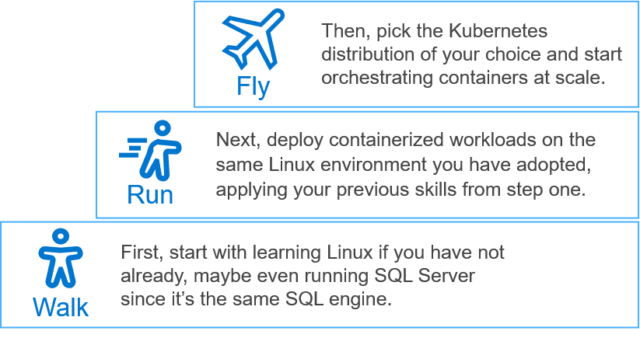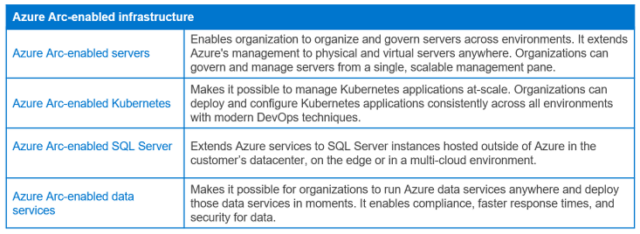When it comes to cloud strategies, a hybrid cloud approach makes it possible to select the optimal location for your data. However, when data is spread across the edge, private, public, and multi-cloud environments, management can become complex. For many customers, the questions usually start with where do I begin, how do I go about integrating all the foundational components (OS, containers, database, etc.) and how do I manage all these data locations? By adopting modern tooling and taking a walk, run, fly, approach to ramping up their tooling and management skills with Azure Arc, they CAN achieve their goals.
What is Azure Arc?
Governance and rapid adoption to DevOps maturity – the continuously evolving customer request. There are proven steps to assess DevOps maturity, but if your organization is trying to measure DevOps maturity, they are not there yet. Embracing Azure Arc as your common control plane, with Azure Resource Manager (ARM), will fulfill the hybrid requirement, that many IT departments are being asked to deliver. With the added benefit of aligning to the initial DevOps maturity steps. Some core tenants, such as Linux, Kubernetes, and ARM templates are required.
If the public cloud simply will not work because of sensitive data or round-trip latencies, a hybrid solution is the logical choice. With Azure Arc, that same public control plain is extended into your data center, or all the way to the edge. Additionally, you can deliver as-a-service offerings to your end-business consumers.
Simply stated – Azure Arc simplifies complex and distributed environments across edge and core on-premises, and multi-cloud (locations and environments) by bringing Azure services to ANY infrastructure while aligning with these prescriptive benefits:
- Gain central visibility, operations, and compliance
- Build cloud native apps anywhere, with manageable scale
- Run Azure Arc enabled data services anywhere, just announced by Microsoft.
The truth is, your business users may already be connecting to Azure, or multi-public-cloud, creating a huge opportunity for providing data governance and logging analytics. How will you control this? Azure Arc can help. The complexity is below the control plane and presented seamlessly with Azure Arc.
To fully embrace Azure Arc, you‘re sort of compelled to adopt newer technologies into your organization. These improvements include Linux, Kubernetes, the Azure Portal, command line scripting and other innovative new technologies.
The promise of hybrid and multi-cloud – actually, implemented
Azure Arc extends Azure services and management to any infrastructure. With Arc, you can now consistently build, deploy, operate, and manage all your workloads running on-premises traditional nodes, physical or virtual environments (hopefully virtual), cloud-native and edge applications, all using a consistent control plane manner.
Azure Arc strikes the balance between traditional server workloads and modern containerized workloads, operating in the exact same context of the hybrid and multi-cloud environments. It brings the Azure control plane to your data center with:
The following architectures have been validated for the Azure Arc control plane:
- Dell EMC PowerMax – with Azure Arc-enabled data services back-ended with PowerMax can consolidate to 64,000 devices/LUNs! Again, those containerized database workloads are easy to manage with Azure Arc leveraging PowerMax’s industry-leading capabilities. PowerMax provides plenty of headroom for replicas and unexpected bursts in storage growth which Kubernetes requires as a solid foundation to maintain its desired deployment state.
- Dell EMC PowerFlex – delivering truly flexible software-defined infrastructure, PowerFlex aligns perfectly to the core tenets of Azure Arc. PowerFlex offers the flexibility to consolidate heterogeneous workloads – across bare-metal OSs, hypervisors and container platforms workloads – without physical segmentation or re-clustering. Organizations can grow from just a few nodes to hundreds, on-demand and non-disruptively, with linearly-scaling performance and network throughput.
- Dell EMC PowerStore – the PowerStore storage appliance is purpose-built for container-based software architecture. This modularity enables feature portability and maximum deployment flexibility automatically balancing storage and workloads to maximize system utility. Each active-active PowerStore appliance can grow to over 2.8 PB effective capacity,¹ and multiple appliances can be clustered for greater performance. This is an excellent fit for Azure Arc data services options like PostgreSQL Hyperscale and of course SQL MI.
- Dell EMC Integrated System for Microsoft Azure Stack HCI – Azure Kubernetes Service on Azure Stack HCI (AS HCI) enables organizations to implement Azure Kubernetes Service (AKS) on-premises. You can take advantage of the ease of use and high security capabilities delivered for containerized applications at scale. Additional integration with Windows Admin Center (WAC) adds another level of management visibility and control, including Dell Technologies integration with WAC. AKS on AS HCI simplifies the process of setting up Kubernetes.
- Dell EMC VxRail with Tanzu – Tanzu Architecture for VxRail, or TA4V, is a purpose-built, validated, tested reference architecture built on VxRail. TA4V is designed for cloud-native workloads with PaaS and CaaS services and delivers a fast and easy way to consume Tanzu Kubernetes Grid. Tanzu Kubernetes Grid on vSphere has been certified for Azure Arc and Azure Arc-enabled data services. This pairs the power of the Tanzu portfolio and the value and flexibility of Azure Arc-enabled data services to offer customers the best of both worlds. With the operational automation from VxRail, companies can seamlessly scale the infrastructure to meet their cloud native application development needs as they grow. You can read more here.
Dell Technologies APEX Data Storage Services
APEX Data Storage Services is Dell Technologies storage-as-a-service offer. It is a portfolio of scalable and elastic storage resources, designed for OpEx², that delivers simplicity, agility and control to our customers’ storage environments. Now you can consistently align expenses and usage with services designed for 99.9999% availability³. This offer has also been validated for Azure Arc, and the two align perfectly. APEX and Azure Arc complement each other when it comes to managing elastic mission critical on-premises workloads — especially databases. Since APEX is based on the aforementioned Dell Technologies validated architectures, you can see that APEX Data Storage Services are compatible with many permutations of common workload choices. As-a-Service offerings, in your datacenter, aligned with both hardware and software are now delivered by Dell Technologies and Microsoft.
Proactive cloud-based monitoring of on-premises infrastructures with Dell EMC CloudIQ
To add even more value to the on-premises landscape, the Dell Technologies offering of CloudIQ, greatly complements any Azure Arc on-premises management. CloudIQ brings a cloud-native Machine Learning (ML) engine to your on-premises storage subsystem. Some capabilities that CloudIQ will deliver dynamically include intelligently predicting capacity, identifying “noisy neighbors” (key for database environments), finding reclaimable storage, plus many others. CloudIQ is supported on PowerMax, PowerFlex, PowerStore and VxRail.
Engage our Dell Technologies Services
In interactions with our Dell clients we discuss a Canonical Model, which is now referred to as the Holistic Model, which I discuss in another blog here. Each time the story is the same: complexity can be over-whelming when architecting a dynamic solution. Dynamic solutions are what your end user customers demand but your business users want “easy”. There are many skill sets required across the layers. Our services teams bridge the technologies and concepts listed above, that many of your teams may not be comfortable with yet (like Linux and Kubernetes). This is where Dell Technologies Services can help. From strategy, implementation, adoption, and scale, by partnering with Dell Technologies you can confidently extend your Microsoft Azure environment to on-premises and to the edge, accelerating innovation and delivering even more value to your business.
Now that you have a better understanding of the business value and opportunities of all things Azure Arc, read my technical blog where I describe details of tooling, configuration, and enablement of Azure Arc. There is so much more to talk about as we’ll dissect the solution and illustrate how all the pieces of the puzzle fit together.
1 Assumes 4:1 average data reduction. Actual results may vary, depending on data types. PowerStore 500 model maximum single-appliance capacity is 1.2PBe per 2U base appliance.
2 OpEx treatment is subject to customer internal accounting review and policies.
3 Based on hardware availability on common underlying platform configurations. Actual hardware availability may vary.



